NCERT Solutions for Class 12 Maths Chapter 1 - Relations and Functions - Exercise 1.1
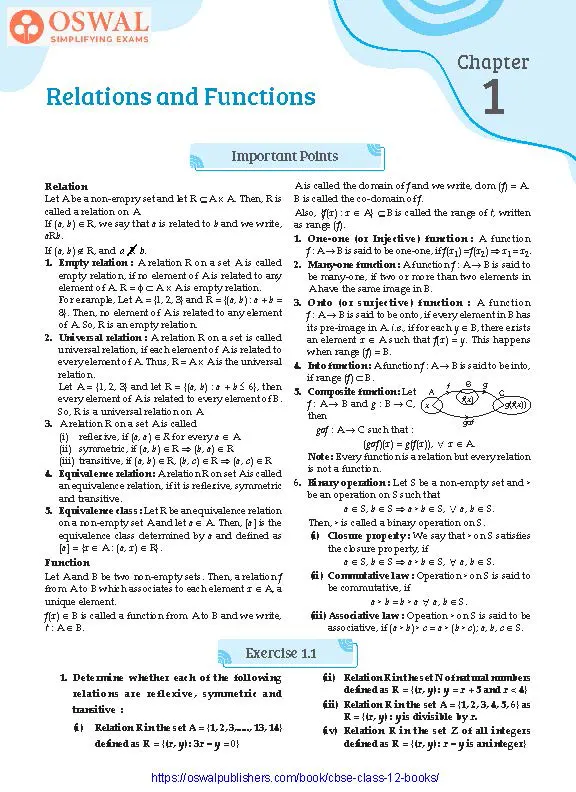
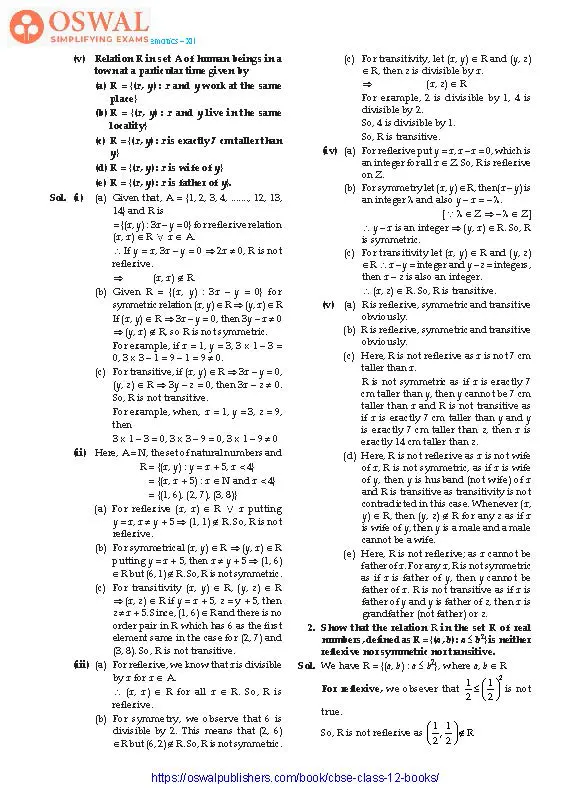
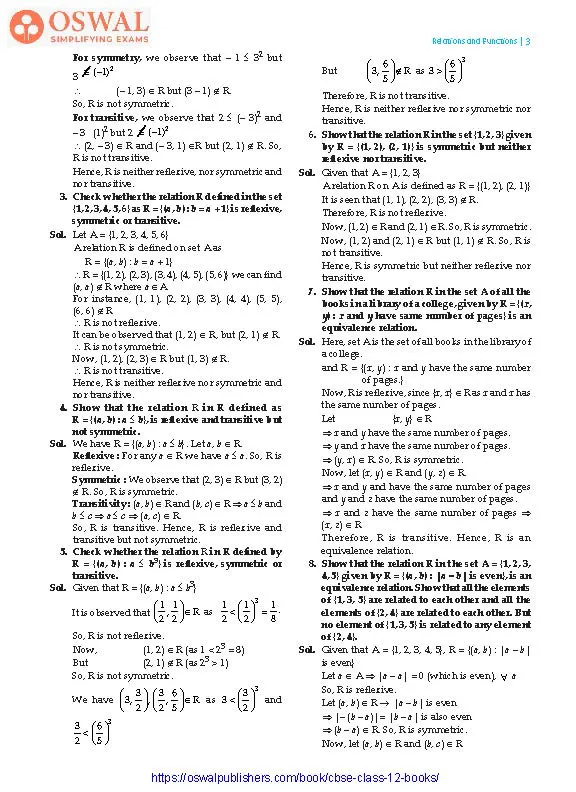
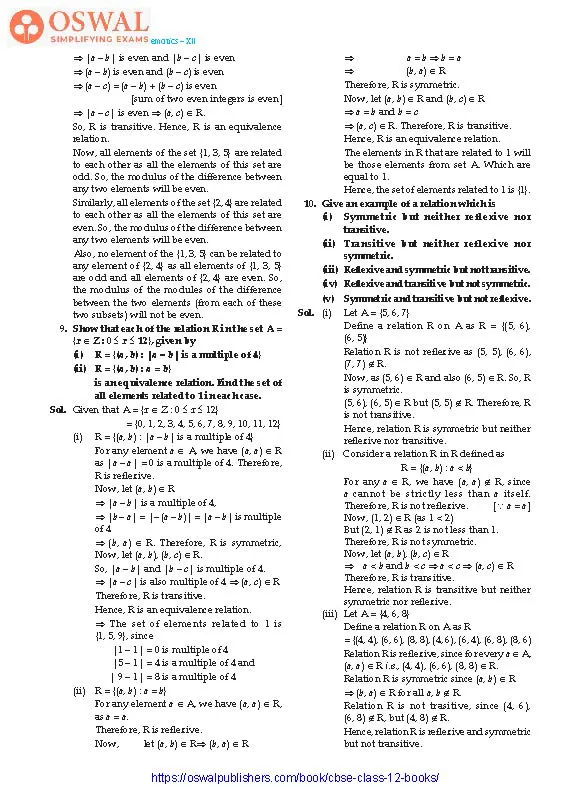
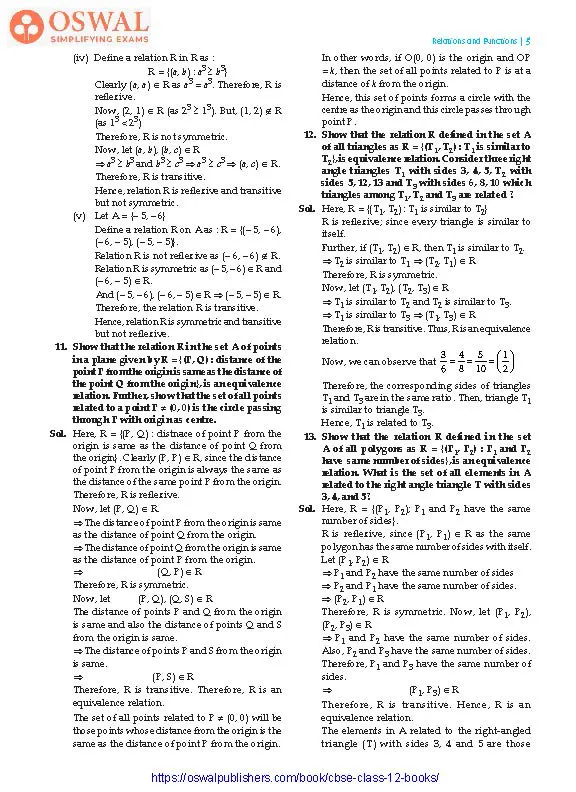
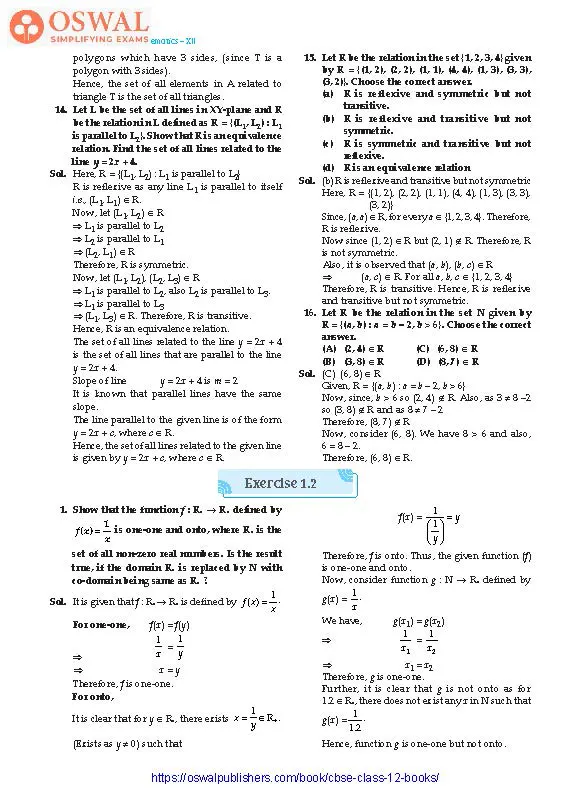
Access Exercises of Class 12 Maths Chapter 1 - Relations and Functions
Exercise 1.1 Solutions : 16 Questions (14 Short Answers, 2 MCQ)
Exercise 1.2 Solutions : 12 Questions (10 Short Answers, 2 MCQ)
Exercise 1.3 Solutions : 14 Questions (12 Short Answers, 2 MCQ)
Exercise 1.4 Solutions : 13 Questions (12 Short Answers, 1 MCQ)
Miscellaneous Exercise Solutions: 19 Questions (7 Long answers, 9 Short Answer Type, 3 MCQs)
Exercise 1.1 :
1. Determine whether each of the following relations are reflexive, symmetric and transitive :
(i) Relation R in the set A = {1, 2, 3,….., 13, 14} defined as R = {(x, y) : 3x – y = 0}
(ii) Relation R in the set N of natural numbers defined as R = {(x, y) : y = x + 5 and x < 4}
(iii) Relation R in the set A = {1, 2, 3, 4, 5, 6} as R = {(x, y) : y is divisible by x.
(iv) Relation R in the set Z of all integers defined as R = {(x, y) : x – y is an integer}
(v) Relation R in set A of human beings in a town at a particular time given by
(a) R = {(x, y) : x and y work at the same place}
(b) R = {(x, y) : x and y live in the same locality}
(c) R = {(x, y) : x is exactly 7 cm taller than y}
(d) R = {(x, y) : x is wife of y}
(e) R = {(x, y) : x is father of y}.
Sol. (i) (a) Given that, A = {1, 2, 3, 4, ......., 12, 13, 14} and R is
= {(x, y) : 3x – y = 0} for reflexive relation (x, x) ∈ R x ∈ A.
∴ If y = x, 3x – y = 0 ⇒ 2x ≠ 0, R is not reflexive.
⇒ (x, x) ∉ R.
(b) Given R = {(x, y) : 3x – y = 0} for symmetric relation (x, y) ∈ R ⇒ (y, x) ∈ R If (x, y) ∈ R ⇒ 3x – y = 0, then 3y – x ≠ 0 ⇒ (y, x) ∉ R, so R is not symmetric.
For example, if x = 1, y = 3, 3 × 1 – 3 = 0, 3 × 3 – 1 = 9 – 1 = 9 ≠ 0.
(c) For transitive, if (x, y) ∈ R ⇒ 3x – y = 0, (y, z) ∈ R ⇒ 3y – z = 0, then 3x – z ≠ 0. So, R is not transitive.
For example, when, x = 1, y = 3, z = 9, then 3 × 1 – 3 = 0, 3 × 3 – 9 = 0, 3 × 1 – 9 ≠ 0
(ii) Here, A = N, the set of natural numbers and
R = {(x, y) : y = x + 5, x < 4}
= {(x, x + 5) : x ∈ N and x < 4}
= {(1, 6), (2, 7), (3, 8)}
(a) For reflexive (x, x) ∈ R ∀ putting y = x, x ≠ y + 5 ⇒ (1, 1) ∉ R. So, R is not reflexive.
(b) For symmetrical (x, y) ∈ R ⇒ (y, x) ∈ R putting y = x + 5, then x ≠ y + 5 ⇒ (1, 6) ∈ R but (6, 1) ∉ R. So, R is not symmetric.
(c) For transitivity (x, y) ∈ R, (y, z) ∈ R ⇒ (x, z) ∈ R if y = x + 5, z = y + 5, then z ≠ x + 5. Since, (1, 6) ∈ R and there is no order pair in R which has 6 as the first element same in the case for (2, 7) and (3, 8). So, R is not transitive.
(iii) (a) For reflexive, we know that x is divisible by x for x ∈ A.
∴ (x, x) ∈ R for all x ∈ R. So, R is reflexive.
(b) For symmetry, we observe that 6 is divisible by 2. This means that (2, 6) ∈ R but (6, 2) ∉ R. So, R is not symmetric.
(c) For transitivity, let (x, y) ∈ R and (y, z) ∈ R, then z is divisible by x.
⇒ (x, z) ∈ R
For example, 2 is divisible by 1, 4 is divisible by 2.
So, 4 is divisible by 1.
So, R is transitive.
(iv) (a) For reflexive put y = x, x – x = 0, which is an integer for all x ∈ Z. So, R is reflexive on Z.
(b) For symmetry let (x, y) ∈ R, then(x – y) is an integer λ and also y – x = – l.
[∴ λ ∈ Z ⇒ – λ ∈ Z]
∴ y – x is an integer ⇒ (y, x) ∈ R. So, R is symmetric.
(c) For transitivity let (x, y) ∈ R and (y, z) ∈ R
∴ x – y = integer and y – z = integers, then x – z is also an integer.
∴ (x, z) ∈ R. So, R is transitive.
(v) (a) R is reflexive, symmetric and transitive obviously.
(b) R is reflexive, symmetric and transitive obviously.
(c) Here, R is not reflexive as x is not 7 cm taller than x. R is not symmetric as if x is exactly 7 cm taller than y, then y cannot be 7 cm taller than x and R is not transitive as if x is exactly 7 cm taller than y and y is exactly 7 cm taller than z, then x is exactly 14 cm taller than z.
(d) Here, R is not reflexive as x is not wife of x, R is not symmetric, as if x is wife of y, then y is husband (not wife) of x and R is transitive as transitivity is not contradicted in this case. Whenever (x, y) ∈ R, then (y, z) ∉ R for any z as if x is wife of y, then y is a male and a male cannot be a wife.
(e) Here, R is not reflexive; as x cannot be father of x. For any x, R is not symmetric as if x is father of y, then y cannot be father of x. R is not transitive as if x is father of y and y is father of z, then x is grandfather (not father) or z.
2. Show that the relation R in the set R of real numbers, defined as R = {(a, b) : a ≤ b2} is neither reflexive nor symmetric nor transitive.
Sol. We have R = {(a, b) : a ≤ b2}, where a, b ∈ R
$$\text{For reflexive, we obsever that}\space\frac{1}{2}≤(\frac{1}{2})^2\space\text{is not true.}$$
$$\text{For reflexive, we obsever that}\space\frac{1}{2}≤(\frac{1}{2})^2\space\text{is not true.}\\\text{So, R is not reflexive as}\space(\frac{1}{2},\frac{1}{2})\notin R$$
For symmetry, we observe that – 1 ≤ 32 but
3 (−1)2
∴ (– 1, 3) ∈ R but (3 – 1) ∉ R.
So, R is not symmetric.
For transitive, we observe that 2 ≤ (– 3)2 and – 3 (1)2 but 2 ≤ (−1)2
∴ (2, – 3) ∈ R and (– 3, 1) ∈R but (2, 1) ∉ R. So, R is not transitive.
Hence, R is neither reflexive, nor symmetric and nor transitive.
3. Check whether the relation R defined in the set {1, 2, 3, 4, 5, 6} as R = {(a, b) : b = a + 1} is reflexive, symmetric or transitive.
Sol. Let A = {1, 2, 3, 4, 5, 6}
A relation R is defined on set A as
R = {(a, b) : b = a + 1}
∴ R = {(1, 2), (2, 3), (3, 4), (4, 5), (5, 6)} we can find
(a, a) ∉ R where a ∈A.
For instance, (1, 1), (2, 2), (3, 3), (4, 4), (5, 5),
(6, 6) ∉ R
∴ R is not reflexive.
It can be observed that (1, 2) ∈ R, but (2, 1) ∉ R.
∴ R is not symmetric.
Now, (1, 2), (2, 3) ∈ R but (1, 3) ∉ R.
∴ R is not transitive.
Hence, R is neither reflexive nor symmetric and nor transitive.
4. Show that the relation R in R defined as R = {(a, b) : a ≤ b}, is reflexive and transitive but not symmetric.
Sol. We have R = {(a, b) : a ≤ b}. Let a, b ∈ R.
Reflexive : For any a ∈ R we have a ≤ a. So, R is reflexive.
Symmetric : We observe that (2, 3) ∈ R but (3, 2) ∉ R. So, R is symmetric.
Transitivity : (a, b) ∈ R and (b, c) ∈ R ⇒ a ≤ b and b ≤ c ⇒ a ≤ c ⇒ (a, c) ∈ R.
So, R is transitive. Hence, R is reflexive and transitive but not symmetric.
5. Check whether the relation R in R defined by R = {(a, b) : a ≤ b3} is reflexive, symmetric or transitive.
Sol. Given that R = {(a, b) : a ≤ b3}
$$\text{It is observed that}\space(\frac{1}{2},\frac{1}{2})\notin R \space\text{as}\space\frac{1}{2}<(\frac{1}{2})^3=\frac{1}{8}$$
So, R is not reflexive.
Now, (1, 2) ∈ R (as 1 < 23 = 8)
But (2, 1) ∉ R (as 23 > 1)
So, R is not symmetric
$$\text{We have}\space(3,\frac{3}{2}),\space(\frac{3}{2},\frac{6}{5})\notin R \space\text{as}\space3<(\frac{3}{2})^3\text{and}\frac{3}{2}<(\frac{6}{5})^3$$
$$\text{But}\space(3,\frac{6}{5})\notin R \space\text{as}\space3>(\frac{6}{5})^3$$
Therefore, R is not transitive.
Hence, R is neither reflexive nor symmetric nor transitive.
6. Show that the relation R in the set {1, 2, 3} given by R = {(1, 2), (2, 1)} is symmetric but neither reflexive nor transitive.
Sol. Given that A = {1, 2, 3}
A relation R on A is defined as R = {(1, 2), (2, 1)} It is seen that (1, 1), (2, 2), (3, 3) ∉ R.
Therefore, R is not reflexive.
Now, (1, 2) ∈ R and (2, 1) ∈ R. So, R is symmetric.
Now, (1, 2) and (2, 1) ∈ R but (1, 1) ∉ R. So, R is not transitive.
Hence, R is symmetric but neither reflexive nor transitive.
7. Show that the relation R in the set A of all the books in a library of a college, given by R = {(x, y) : x and y have same number of pages} is an equivalence relation.
Sol. Here, set A is the set of all books in the library of a college.
and R = {(x, y) : x and y have the same number of pages.}
Now, R is reflexive, since {x, x} ∈ R as x and x has the same number of pages.
Let {x, y} ∈ R
⇒ x and y have the same number of pages.
⇒ y and x have the same number of pages.
⇒ (y, x) ∈ R. So, R is symmetric.
Now, let (x, y) ∈ R and (y, z) ∈ R.
⇒ x and y and have the same number of pages
and y and z have the same number of pages.
⇒ x and z have the same number of pages ⇒
(x, z) ∈ R
Therefore, R is transitive. Hence, R is an equivalence relation.
8. Show that the relation R in the set A = {1, 2, 3, 4, 5} given by R = {(a, b) : |a – b| is even}, is an equivalence relation. Show that all the elements of {1, 3, 5} are related to each other and all the elements of {2, 4} are related to each other. But no element of {1, 3, 5} is related to any element of {2, 4}.
Sol. Given that A = {1, 2, 3, 4, 5}, R = {(a, b) : |a – b| is even}
Let a ∈ A ⇒ |a – a| = 0 (which is even), ∀ a
So, R is reflexive.
Let (a, b) ∈ R → |a – b| is even
⇒ |– (b – a)|= |b – a| is also even
⇒ (b – a) ∈ R. So, R is symmetric.
Now, let (a, b) ∈ R and (b, c) ∈ R
⇒ |a – b| is even and |b – c| is even
⇒ (a – b) is even and (b – c) is even
⇒ (a – c) = (a – b) + (b – c) is even
[sum of two even integers is even]
⇒ |a – c| is even ⇒ (a, c) ∈ R.
So, R is transitive. Hence, R is an equivalence relation.
Now, all elements of the set {1, 3, 5} are related to each other as all the elements of this set are odd. So, the modulus of the difference between any two elements will be even.
Similarly, all elements of the set {2, 4} are related to each other as all the elements of this set are even. So, the modulus of the difference between any two elements will be even.
Also, no element of the {1, 3, 5} can be related to any element of {2, 4} as all elements of {1, 3, 5} are odd and all elements of {2, 4} are even. So, the modulus of the modules of the difference between the two elements (from each of these two subsets) will not be even.
9. Show that each of the relation R in the set A = {x ∈ Z : 0 ≤ x ≤ 12}, given by
(i) R = {(a, b) : |a – b| is a multiple of 4}
(ii) R = {(a, b) : a = b}
is an equivalence relation. Find the set of all elements related to 1 in each case.
Sol. Given that A = {x ∈ Z : 0 ≤ x ≤ 12} = {0, 1, 2, 3, 4, 5, 6, 7, 8, 9, 10, 11, 12}
(i) R = {(a, b) : |a – b| is a multiple of 4}
For any element a ∈ A, we have (a, a) ∈ R
as |a – a| = 0 is a multiple of 4. Therefore,
R is reflexive.
Now, let (a, b) ∈ R
⇒ |a – b| is a multiple of 4,
⇒ |b – a| = |– (a – b)| = |a – b| is multiple of 4
⇒ (b, a) ∈ R. Therefore, R is symmetric,
Now, let (a, b), (b, c) ∈ R.
So, |a – b| and |b – c| is multiple of 4.
⇒ |a – c| is also multiple of 4 ⇒ (a, c) ∈ R
Therefore, R is transitive.
Hence, R is an equivalence relation.
⇒ The set of elements related to 1 is
{1, 5, 9}, since
|1 – 1| = 0 is multiple of 4
|5 – 1| = 4 is a multiple of 4 and
| 9 – 1| = 8 is a multiple of 4
(ii) R = {(a, b) : a = b}
For any element a ∈ A, we have (a, a) ∈ R,
as a = a.
Therefore, R is reflexive.
Now, let (a, b) ∈ R⇒ (b, a) ∈ R
⇒ a = b ⇒ b = a
⇒ (b, a) ∈ R
Therefore, R is symmetric.
Now, let (a, b) ∈ R and (b, c) ∈ R
⇒ a = b and b = c
⇒ (a, c) ∈ R. Therefore, R is transitive.
Hence, R is an equivalence relation.
The elements in R that are related to 1 will be those elements from set A. Which are equal to 1.
Hence, the set of elements related to 1 is {1}.
10. Give an example of a relation which is
(i) Symmetric but neither reflexive nor transitive.
(ii) Transitive but neither reflexive nor symmetric.
(iii) Reflexive and symmetric but not transitive.
(iv) Reflexive and transitive but not symmetric.
(v) Symmetric and transitive but not reflexive.
Sol. (i) Let A = {5, 6, 7} Define a relation R on A as
R = {(5, 6), (6, 5)} Relation R is not reflexive as (5, 5), (6, 6), (7, 7) ∉ R.
Now, as (5, 6) ∈ R and also (6, 5) ∈ R. So, R
is symmetric.
(5, 6), (6, 5) ∈ R but (5, 5) ∉ R. Therefore, R is not transitive.
Hence, relation R is symmetric but neither reflexive nor transitive.
(ii) Consider a relation R in R defined as
R = {(a, b) : a < b}
For any a ∈ R, we have (a, a) ∉ R, since
a cannot be strictly less than a itself.
Therefore, R is not reflexive. [∴ a = a]
Now, (1, 2) ∈ R (as 1 < 2)
But (2, 1) ∉ R as 2 is not less than 1.
Therefore, R is not symmetric.
Now, let (a, b), (b, c) ∈ R
⇒ a < b and b < c ⇒ a < c ⇒ (a, c) ∈ R
Therefore, R is transitive.
Hence, relation R is transitive but neither symmetric nor reflexive.
(iii) Let A = {4, 6, 8} Define a relation R on A as
R = {(4, 4), (6, 6), (8, 8), (4, 6), (6, 4), (6, 8), (8, 6)
Relation R is reflexive, since for every a ∈ A,
(a, a) ∈ R i.e., (4, 4), (6, 6), (8, 8) ∈ R.
Relation R is symmetric since (a, b) ∈ R
⇒ (b, a) ∈ R for all a, b ∉ R.
Relation R is not trasitive, since (4, 6),
(6, 8) ∉ R, but (4, 8) ∉ R.
Hence, relation R is reflexive and symmetric but not transitive.
(iv) Define a relation R in R as :
R = {(a, b) : a3 ≥ b3}
Clearly (a, a) ∈ R as a3 = a3. Therefore, R is reflexive.
Now, (2, 1) ∈ R (as 23 ≥ 13). But, (1, 2) ∉ R
(as 13 < 23)
Therefore, R is not symmetric.
Now, let (a, b), (b, c) ∈ R
⇒ a3 ≥ b3 and b3 ≥ c3 ⇒ a3 ≥ c3 ⇒ (a, c) ∈ R.
Therefore, R is transitive.
Hence, relation R is reflexive and transitive but not symmetric.
(v) Let A = {– 5, – 6}
Define a relation R on A as : R = {(– 5, – 6), (– 6, – 5), (– 5, – 5)}.
Relation R is not reflexive as (– 6, – 6) ∉ R.
Relation R is symmetric as (– 5, – 6) ∈ R and (– 6, – 5) ∈ R.
And (– 5, – 6), (– 6, – 5) ∈ R ⇒ (– 5, – 5) ∈ R.
Therefore, the relation R is transitive. Hence, relation R is symmetric and transitive
but not reflexive.
11. Show that the relation R in the set A of points in a plane given by R = {(P, Q) : distance of the point P from the origin is same as the distance of the point Q from the origin}, is an equivalence relation. Further, show that the set of all points related to a point P ≠ (0, 0) is the circle passing through P with origin as centre.
Sol. Here, R = {(P, Q) : distnace of point P from the origin is same as the distance of point Q from the origin}. Clearly (P, P) ∈ R, since the distance of point P from the origin is always the same as the distance of the same point P from the origin.
Therefore, R is reflexive.
Now, let (P, Q) ∈ R.
⇒ The distance of point P from the origin is same as the distance of point Q from the origin.
⇒ The distance of point Q from the origin is same as the distance of point P from the origin.
⇒ (Q, P) ∈ R
Therefore, R is symmetric.
Now, let (P, Q), (Q, S) ∈ R
The distance of points P and Q from the origin is same and also the distance of points Q and S from the origin is same.
⇒ The distance of points P and S from the origin is same.
⇒ (P, S) ∈ R
Therefore, R is transitive. Therefore, R is an equivalence relation.
The set of all points related to P ≠ (0, 0) will be those points whose distance from the origin is the same as the distance of point P from the origin.
In other words, if O(0, 0) is the origin and OP
= k, then the set of all points related to P is at a distance of k from the origin.
Hence, this set of points forms a circle with the centre as the origin and this circle passes through point P.
12. Show that the relation R defined in the set A of all triangles as R = {(T1, T2) : T1 is similar to T2}, is equivalence relation. Consider three right angle triangles T1 with sides 3, 4, 5, T2 with sides 5, 12, 13 and T3 with sides 6, 8, 10 which triangles among T1, T2 and T3 are related ?
Sol. Here, R = {(T1, T2) : T1 is similar to T2} R is reflexive; since every triangle is similar to itself.
Further, if (T1, T2) ∈ R, then T1 is similar to T2.
⇒ T2 is similar to T1 ⇒ (T2, T1) ∈ R Therefore, R is symmetric.
Now, let (T1, T2), (T2, T3) ∈ R
⇒ T1 is similar to T2 and T2 is similar to T3.
⇒ T1 is similar to T3 ⇒ (T1, T3) ∈ R
Therefore, R is transitive. Thus, R is an equivalence relation.
$$\text{Now, we can observe that}\space\frac{3}{6}=\frac{4}{8}=\frac{5}{10}(\frac{1}{2})$$
Therefore, the corresponding sides of triangles
T1 and T3 are in the same ratio. Then, triangle T1
is similar to triangle T3.
Hence, T1 is related to T3.
13. Show that the relation R defined in the set A of all polygons as R = {(P1, P2) : P1 and P2 have same number of sides}, is an equivalence relation. What is the set of all elements in A related to the right angle triangle T with sides 3, 4, and 5?
Sol. Here, R = {(P1, P2); P1 and P2 have the same
number of sides}.
R is reflexive, since (P1, P1) ∈ R as the same
polygon has the same number of sides with itself.
Let (P1, P2) ∈ R
⇒ P1 and P2 have the same number of sides
⇒ P2 and P1 have the same number of sides.
⇒ (P2, P1) ∈ R
Therefore, R is symmetric. Now, let (P1, P2),
(P2, P3) ∈ R
⇒ P1 and P2 have the same number of sides.
Also, P2 and P3 have the same number of sides.
Therefore, P1 and P3 have the same number of sides.
⇒ (P1, P3) ∈ R
Therefore, R is transitive. Hence, R is an equivalence relation.
The elements in A related to the right-angled triangle (T) with sides 3, 4 and 5 are those polygons which have 3 sides, (since T is a polygon with 3 sides).
Hence, the set of all elements in A related to triangle T is the set of all triangles.
14. Let L be the set of all lines in XY-plane and R be the relation in L defined as R = {(L1, L2) : L1 is parallel to L2}. Show that R is an equivalence relation. Find the set of all lines related to the line y = 2x + 4.
Sol. Here, R = {(L1, L2) : L1 is parallel to L2} R is reflexive as any line L1 is parallel to itself i.e., (L1, L1) ∈ R.
Now, let (L1, L2) ∈ R
⇒ L1 is parallel to L2
⇒ L2 is parallel to L1
⇒ (L2, L1) ∈ R
Therefore, R is symmetric.
Now, let (L1, L2), (L2, L3) ∈ R
⇒ L1 is parallel to L2, also L2 is parallel to L3.
⇒ L1 is parallel to L3
⇒ (L1, L3) ∈ R. Therefore, R is transitive.
Hence, R is an equivalence relation.
The set of all lines related to the line y = 2x + 4 is the set of all lines that are parallel to the line y = 2x + 4.
Slope of line y = 2x + 4 is m = 2 It is known that parallel lines have the same slope.
The line parallel to the given line is of the form y = 2x + c, where c ∈ R.
Hence, the set of all lines related to the given line is given by y = 2x + c, where c ∈ R.
15. Let R be the relation in the set {1, 2, 3, 4} given by R = {(1, 2), (2, 2), (1, 1), (4, 4), (1, 3), (3, 3), (3, 2)}. Choose the correct answer.
(a) R is reflexive and symmetric but not transitive.
(b) R is reflexive and transitive but not symmetric.
(c) R is symmetric and transitive but not reflexive.
(d) R is an equivalence relation
Sol. (b) R is reflexive and transitive but not symmetric
Here, R = {(1, 2), (2, 2), (1, 1), (4, 4), (1, 3), (3, 3), (3, 2)}
Since, (a, a) ∈ R, for every a ∈ {1, 2, 3, 4}. Therefore, R is reflexive.
Now since (1, 2) ∈ R but (2, 1) ∉ R. Therefore, R is not symmetric.
Also, it is observed that (a, b), (b, c) ∈ R
⇒ (a, c) ∈ R. For all a, b, c ∈ {1, 2, 3, 4}
Therefore, R is transitive. Hence, R is reflexive and transitive but not symmetric.
16. Let R be the relation in the set N given by R = {(a, b) : a = b – 2, b > 6}. Choose the correct answer.
(A) (2, 4) ∈ R
(B) (3, 8) ∈ R
(C) (6, 8) ∈ R
(D) (8, 7) ∈ R
Sol. (C) (6, 8) ∈ R
Given, R = {(a, b) : a = b – 2, b > 6}
Now, since, b > 6 so (2, 4) ∉ R. Also, as 3 ≠ 8 –2
so (3, 8) ∉ R and as 8 ≠ 7 – 2
Therefore, (8, 7) ∉ R
Now, consider (6, 8). We have 8 > 6 and also, 6 = 8 – 2.
Therefore, (6, 8) ∈ R.
